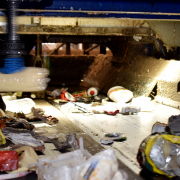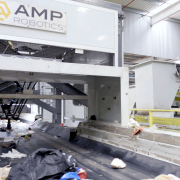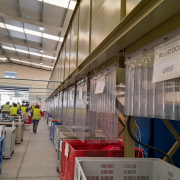China’s First AI-Powered Hyperspectral Optical Sorter for Mixed Textiles
This year, Chinese DataBeyond Technology, a high-tech company specializing in AI and optoelectronic integration-based intelligent sorting equipment, has launched the country’s first “AI-powered hyperspectral optical sorter for blended fabrics”.
The new machine integrates – according to the information – advanced artificial intelligence algorithms with hyperspectral recognition technology. “This breakthrough successfully addresses the long-standing challenges in the sorting of blended fabrics, marking a pivotal milestone in DataBeyond Technology’s efforts to drive transformation and upgrades in the textile recycling industry.” a press release said. The sorting of blended fabrics is a problem for the textile recycling industry, the company described the situation that is similar to the circumstances in many countries worldwide. “Blended textiles are made from a mix of various materials with complex and uneven distribution, making it difficult for traditional sorting methods to efficiently and accurately separate these materials. As a result, a large portion of blended fabric waste is either incinerated or landfilled, causing significant resource wastage and environmental damage.” In response to this challenge, DataBeyond Technology developed the “AI-powered hyperspectral sorter for blended fabrics,” enabling precise separation of textiles containing multiple material components.
The company is convinced that this technology provides a solution for the efficient sorting and recycling of blended fabrics. The developed novel instrument realizes:
- Precision Sorting: The sorter is equipped with hyperspectral sensors that capture 256 spectral bands, allowing for full-spectrum recognition of textile waste. It can accurately sort textiles with 30-80 percent polyester content, nylon content, spandex content, and cotton content, achieving a sorting accuracy rate of up to 99 percent. This provides high-quality raw materials for downstream chemical recycling processes.
- Flexible Adaptability: In response to the ever-changing market conditions, the sorter can be easily adjusted to meet customer needs. It allows for flexible switching between sorting targets, facilitating efficient matching with downstream processing requirements, and significantly increasing the resource value of blended fabric waste.
“The release of the ‘AI-powered hyperspectral sorter for blended fabrics’ marks a historic step forward in the recycling of textile waste,” the Chinese firm emphasized. “This cutting-edge technology will enable the recycling industry to unlock greater value from blended textile waste, opening new profit opportunities for the textile recycling sector and accelerating the arrival of a new era of smart recycling in the industry.”
(Published in GLOBAL RECYCLING Magazine 1/2025, Page 34, Screenshot: Video DataBeyond Technology)









